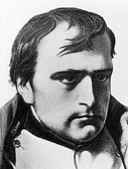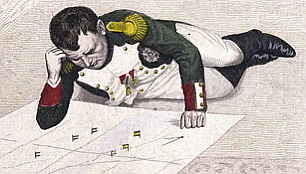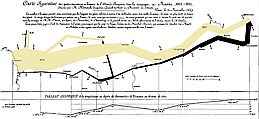|
Napoleon Bonaparte One of the most recognizable historical figures of all time, which explains why Napoleon is the only character to appear in both Bill and Ted's Excellent Adventure and Time Bandits. Same goes for why you can always find one in any well-stocked insane asylum.
One of the most recognizable historical figures of all time, which explains why Napoleon is the only character to appear in both Bill and Ted's Excellent Adventure and Time Bandits. Same goes for why you can always find one in any well-stocked insane asylum.
In June 1798, Napoleon joined the Freemasons in Malta. Later he would appoint his four brothers to high posts in the organization. Napoleon staged a coup in November 1799, declared himself Emperor of France, and proceeded to rebuild the country to suit his whims. In 1801 he threw the Marquis de Sade in prison without a trial for publishing pornography.
Evidently somebody thought it was a good idea to visit Russia just in time to catch its spectacular autumnal foliage. But it wasn't. More than a century later, Adolf Hitler would make precisely the same mistake.
In May 1814, Napoleon was exiled to his winter home on the Italian island of Elba. He received the title of Emperor of Elba, ruling over a measly population of 110,000. But after nine months he returned to France with 6,000 of his personal guard and immediately reconstructed his army. He managed to assemble a force of 72,000 men before marching into Belgium.
One possible blame for the failure at Waterloo was the Emperor's health. According to the theory, if only the French forces had joined the opposing forces earlier, he would have prevailed. But Napoleon was unable to travel due to his condition; that being, horrifically painful hemorrhoids. Anyway, this time he was exiled to a smaller, more remote island in the South Atlantic named St. Helena. There he brooded, complained incessantly about the rudeness of the British governor of the place, and wrote his memoirs. After six years of captivity, he finally croaked. Attempts to determine whether Napoleon had been assassinated on St. Helena have turned out inconclusive. According to neutron activation of souvenir hair samples taken from his fresh corpse, the man had accumulated fairly high levels of heavy metal: 1.5 parts per million of arsenic and 6 ppm antimony. But it's unclear whether this was the result of a sudden dose of poison, or rather the long and gradual exposure to haircare products, glue, wallpaper, wood ash, and so on. For his part, Napoleon made his suspicions known in his will:
I die prematurely, assassinated by the English oligarchy and its tool. The English nation will not be slow in avenging me. Of course, this was after six years on St. Helena. Napoleon should have realized that if the British were indeed trying to kill him, they would have just thrown him overboard on the way to the island and avoided the whole trouble and expense.
|
 Desperately in need of funds, France executed the Louisiana Clearance Sale, offloading the North American real estate for millions in gold bullion. With that pocket change, Napoleon embarked upon a military campaign to build his empire. Then followed a decade-long string of successful conquests, until things began to sour in 1812.
Desperately in need of funds, France executed the Louisiana Clearance Sale, offloading the North American real estate for millions in gold bullion. With that pocket change, Napoleon embarked upon a military campaign to build his empire. Then followed a decade-long string of successful conquests, until things began to sour in 1812.
 The only good thing to come out of Napoleon's disastrous assault on Moscow was the resulting chart drawn up by French engineer Charles Joseph Minard. What Edward R. Tufte calls "probably the best statistical graphic ever drawn," the diagram communicates six dimensions of data on a two-dimensional surface. It's an undisputed classic of information design, and well worth the money. In fact, our analysts feel this gem of statistical elegance justifies the entire campaign and massive loss of life.
The only good thing to come out of Napoleon's disastrous assault on Moscow was the resulting chart drawn up by French engineer Charles Joseph Minard. What Edward R. Tufte calls "probably the best statistical graphic ever drawn," the diagram communicates six dimensions of data on a two-dimensional surface. It's an undisputed classic of information design, and well worth the money. In fact, our analysts feel this gem of statistical elegance justifies the entire campaign and massive loss of life.
 Which is where the Battle of Waterloo took place, just a few miles south of Brussels, on June 18, 1815. There the armies of Wellington and Blücher were waiting for him. A total of 191,300 soldiers met on the battlefield that day; 48,500 were killed or otherwise incapacitated. Napoleon bore the brunt of it and hastily retreated back to France.
Which is where the Battle of Waterloo took place, just a few miles south of Brussels, on June 18, 1815. There the armies of Wellington and Blücher were waiting for him. A total of 191,300 soldiers met on the battlefield that day; 48,500 were killed or otherwise incapacitated. Napoleon bore the brunt of it and hastily retreated back to France.